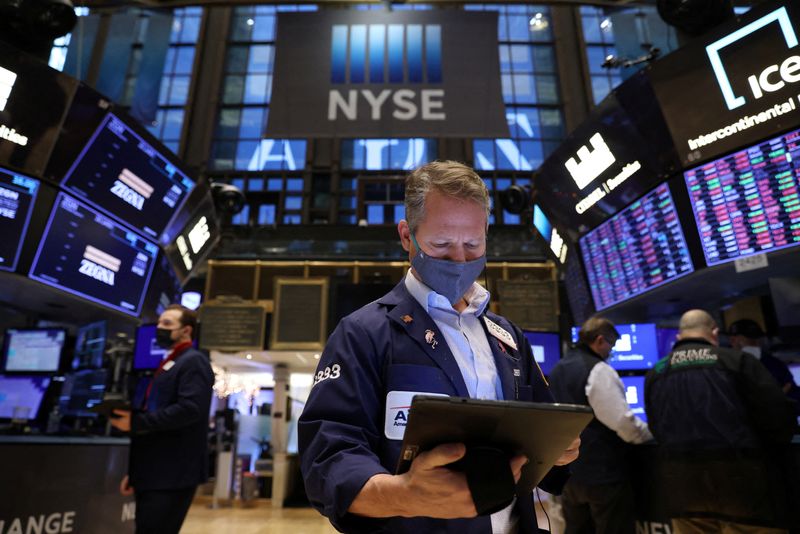By Lewis Krauskopf, Shreyashi Sanyal and Anisha Sircar
(Reuters) - Wall Street's main indexes powered higher on Wednesday in a broad rally after upbeat economic data and hopeful developments about the severity of the Omicron coronavirus variant that is sweeping the world.
The S&P 500 gained at least 1% for a second straight session, putting it near record levels, as volatility has ratcheted up in the last month of 2021 following the arrival of Omicron and an otherwise strong year for equities.
A South African study suggested reduced risks of hospitalization and severe disease in people infected with the Omicron variant versus the Delta one, but World Health Organization officials cautioned that it was too soon to draw firm conclusions.
“We are still struggling for direction in the face of the Omicron outbreak, but in the past few days ... more and more evidence is building that the strain is potentially less severe than prior strains, specifically Delta, which bodes well for economic momentum in 2022,” said Mike Stritch, chief investment officer at BMO Wealth Management.
The Dow Jones Industrial Average rose 261.19 points, or 0.74%, to 35,753.89, the S&P 500 gained 47.33 points, or 1.02%, to 4,696.56 and the Nasdaq Composite added 180.81 points, or 1.18%, to 15,521.89.
All major S&P 500 sectors gained, with the consumer discretionary group up 1.7% and technology up 1.3%.
Tesla (NASDAQ:TSLA) Inc shares rose 7.5%, boosting the S&P 500 and Nasdaq. Tesla Chief Executive Elon Musk said in an interview he has sold "enough stock" following several weeks of share sales by the billionaire.
U.S. consumer confidence improved further in December, suggesting the economy would continue to expand in 2022. The survey from the Conference Board showed more consumers planned to buy a house and big-ticket items such as motor vehicles and major household appliances as well as go on vacation over the next six months.
Other reports showed U.S. home sales increased for a third straight month in November, and that gross domestic product increased at a 2.3% annualized rate in the July-September quarter, revised up from the 2.1% rate estimated last month.
In another encouraging development against the pandemic, the United States authorized Pfizer Inc (NYSE:PFE)'s oral antiviral COVID-19 pill for at-risk people aged 12 and above, making it the first at-home treatment for the coronavirus. Pfizer shares rose 1%.
The benchmark S&P 500 is now up 25% so far in 2021. Still, the environment for equities could be changing heading into next year as the Federal Reserve is expected to begin raising interest rates in 2022 to rein in inflation.
The market is "certainly at an extended level of valuation," said Rick Meckler, partner at Cherry Lane Investments in New Vernon, New Jersey. “Next year is a more difficult picture, but if inflation is going to be part of the problem, I think investors will certainly choose stocks over bonds.”
Advancing issues outnumbered declining ones on the NYSE by a 3.17-to-1 ratio; on Nasdaq, a 1.65-to-1 ratio favored advancers.

The S&P 500 posted 15 new 52-week highs and no new lows; the Nasdaq Composite recorded 35 new highs and 99 new lows.
About 8.6 billion shares changed hands in U.S. exchanges, below the 11.8 billion daily average over the last 20 sessions.